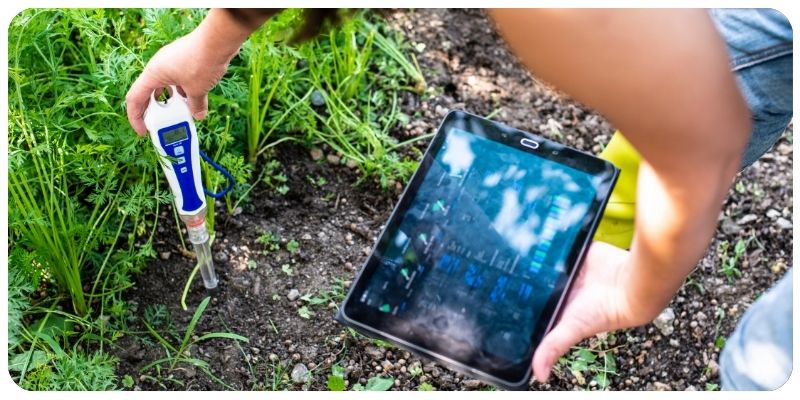
Understanding Soil pH and How It Affects Plants
Soil pH is one of the most important factors that influence plant health, yet it is often overlooked by gardeners. Understanding soil pH and how it affects plant growth can help you make informed decisions about the type of plants to grow and how to manage your garden for optimal results. In this guide, we will dive into the basics of soil pH, how it impacts plants, and what you can do to adjust your soil's pH for healthier, more productive plants.
1. What is Soil pH?
Soil pH measures the acidity or alkalinity of the soil on a scale from 0 to 14. A pH of 7 is considered neutral, while values below 7 indicate acidic soil, and values above 7 indicate alkaline soil. Most plants prefer soil that is slightly acidic, with a pH between 6 and 7, but different plants have different pH requirements.
How is Soil pH Measured?
Soil pH is measured using a pH meter, pH test kit, or by sending a sample to a lab for analysis. The test results will help you determine whether your soil is too acidic, too alkaline, or just right for the plants you intend to grow.
2. How Does Soil pH Affect Plants?
Soil pH affects the availability of nutrients to plants. In soils that are too acidic or too alkaline, certain nutrients may become less available, leading to nutrient deficiencies and poor plant growth. Additionally, extreme pH levels can affect the microbial activity in the soil, further impacting plant health.
Nutrient Availability and Soil pH
Here’s how pH affects the availability of key nutrients:
- Acidic Soils (pH below 6): Nutrients like phosphorus, calcium, and magnesium become less available, while elements like aluminum and manganese can reach toxic levels.
- Neutral to Slightly Acidic Soils (pH 6-7): This is the ideal range for most plants, where nutrients are most available.
- Alkaline Soils (pH above 7): Iron, manganese, and phosphorus may become unavailable to plants, leading to nutrient deficiencies.
Plant Growth and Soil pH
Plants that are grown in soil with the wrong pH level can exhibit signs of poor growth, yellowing leaves, or stunted development. Acid-loving plants like blueberries, azaleas, and rhododendrons prefer a pH between 4.5 and 6.0, while plants like lavender and succulents thrive in more alkaline soil (pH 7 to 8).
3. How to Test and Adjust Soil pH
Before adjusting your soil's pH, it’s essential to test it. Regularly testing your soil will help you track changes over time and determine what adjustments are necessary.
How to Test Soil pH
You can test your soil’s pH using one of the following methods:
- pH Test Kits: Available at most garden centers, these kits allow you to measure pH by adding a chemical solution to a soil sample and comparing the color to a pH chart.
- pH Meters: These are electronic devices that provide a digital pH reading when inserted into the soil.
- Lab Testing: For the most accurate results, consider sending a soil sample to a professional lab for a complete analysis.
4. How to Adjust Soil pH
If your soil’s pH is too high or too low for the plants you want to grow, there are ways to adjust it. The goal is to gradually change the pH and monitor the effects over time.
Raising Soil pH (Making it Less Acidic)
If your soil is too acidic, you can raise the pH by adding materials like lime or wood ash. These materials contain calcium, which neutralizes the acidity in the soil.
- Lime: Agricultural lime is the most common material used to raise soil pH. It is available in several forms, including ground limestone and dolomitic lime, which also adds magnesium.
- Wood Ash: This byproduct of burning wood is high in calcium and can be used to raise soil pH, though it should be applied sparingly.
Lowering Soil pH (Making it More Acidic)
To lower the pH of alkaline soil, you can add materials like sulfur or organic matter. These substances help acidify the soil and make nutrients more available to plants that prefer lower pH levels.
- Sulfur: Elemental sulfur or aluminum sulfate can be applied to soil to reduce its pH.
- Organic Matter: Adding compost, peat moss, or pine needles can help acidify the soil over time.
5. Managing Soil pH for Different Plants
Different plants thrive in different pH levels. Here are some examples of plants and their preferred pH ranges:
Acid-Loving Plants
- Blueberries: pH 4.5-5.5
- Azaleas: pH 4.5-6.0
- Rhododendrons: pH 4.5-6.0
- Camellias: pH 5.0-6.0
Neutral pH Plants
- Tomatoes: pH 6.0-7.0
- Cucumbers: pH 6.0-7.5
- Roses: pH 6.0-7.0
- Carrots: pH 6.0-7.0
Alkaline-Tolerant Plants
- Lavender: pH 7.0-8.0
- Sage: pH 7.0-8.5
- Thyme: pH 7.0-8.0
- Succulents: pH 7.0-8.0
Conclusion
Understanding soil pH is essential for successful gardening. By testing and adjusting your soil’s pH, you can create the ideal environment for your plants to thrive. Whether you’re growing acid-loving blueberries or alkaline-tolerant lavender, knowing your soil's pH will help you optimize nutrient availability and promote healthy plant growth.